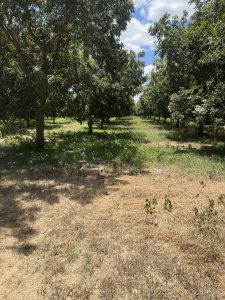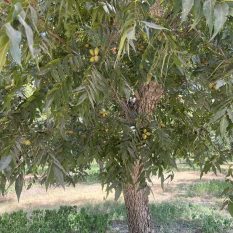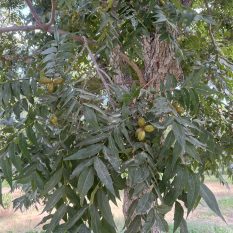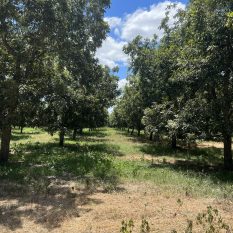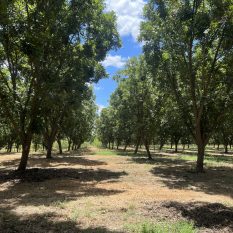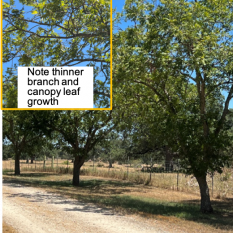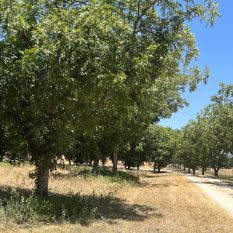Observations from the Orchard on Regenerative Agriculture
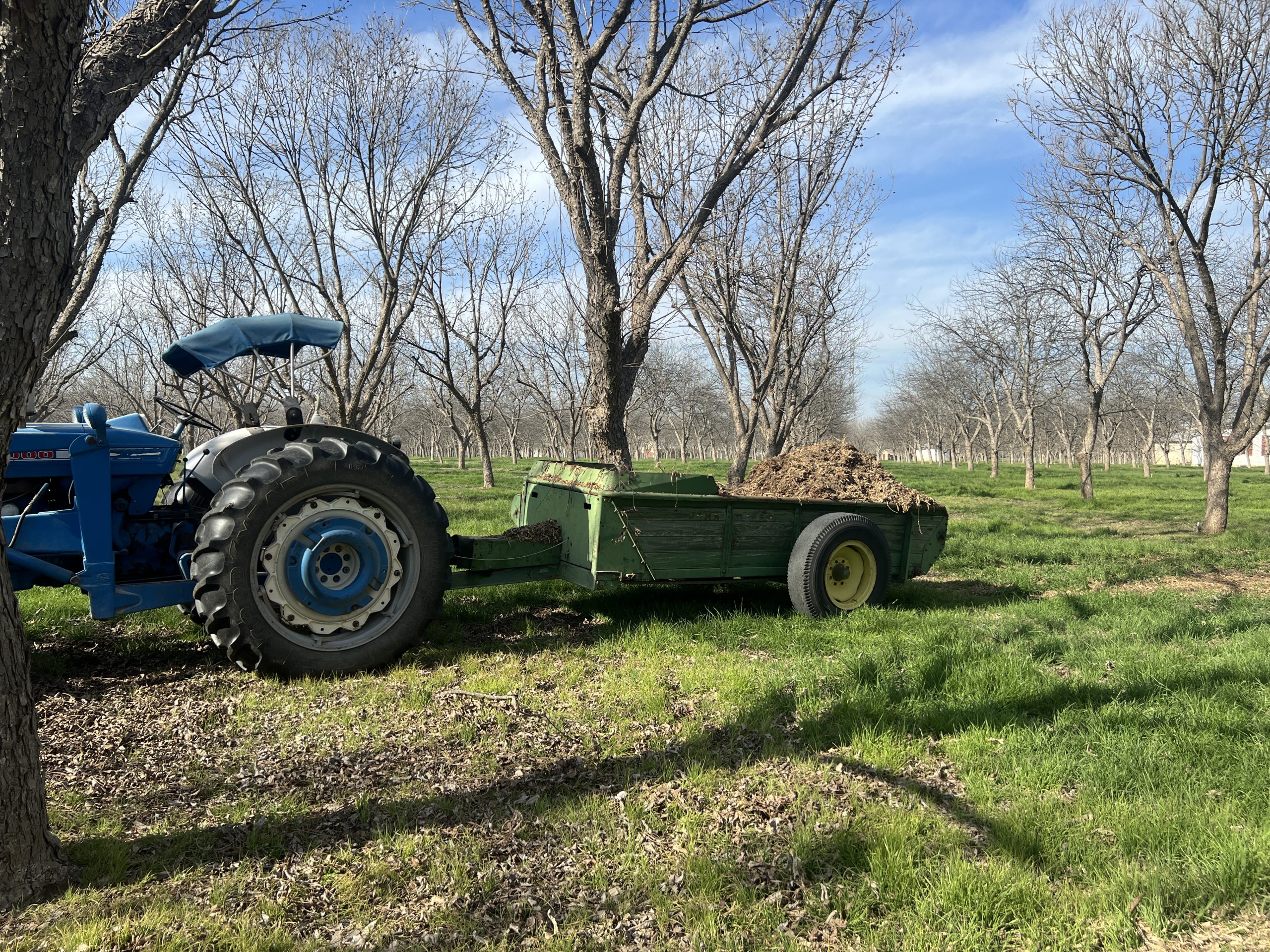
Spreading mulch wood chips at Comal Pecan Farm in New Braunfels, Texas. (Photo by Mark Friesenhahn)
I started planting pecans in 1989 and have followed traditional research and Extension pecan management strategies until recently.[1] After planting, I successfully established my trees and moved into production. But nut set was erratic with large on/off year production swings. The yield per acre was below par. About three years ago, I asked myself: “What can I do to improve nut set and yield and soil deficiencies identified by tests?”
I believe the answer is modifying how we manage our trees and embracing Regenerative (“Sustainable”) Agricultural practices. This is my third year adopting and deploying Regenerative Ag practices, and I feel strongly that we’re on the right track.
Our job on that July day was to spray carbon-based micronutrients as part of our new Regenerative Ag pecan management program. Our new program focuses on improving soil health with regenerative programs, while achieving our cost and budget targets. The program is significantly different than our traditional one in two important ways:
- the fertilizer compounds are carbon (organic) based, not synthetic,
- and although new spray programs contain high concentrations of nitrogen, phosphate, and potash (N-P-K), application rates are small compared to our earlier conventional programs.
For example, the 0-31-50 foliar spray was applied at a rate of 2 pounds per acre, or about 0.6 pounds per acre P and a pound per acre of potash. Our conventional 2022 fertilization program (19-19-5 + humic acid) contained 15 pounds per acre nitrogen and phosphate and 4 pounds per acre potash per application.
My cleaning plant and equipment operator, Lupe Gomez, sprayed two ground-applied micronutrients with a boom sprayer. One contained 2-15-2 fertilizer (2% nitrogen, 15% phosphate, and 2% potash), 5% organic acids and 4% humic acid, and the second contained 0-0-5 fertilizer (5% potash), 10% organic acids and 12% humic acid.
I sprayed two foliar micronutrients with our Savage sprayer. One contained 0-31-50 fertilizer (31% phosphate, 50% potash) and the second contained minerals and zinc (2% boron, 2% copper, 6% iron, 6% manganese. 0.001% molybdenum, 6% zinc).
Calibrated spraying involves driving up and down the rows at 3 miles per hour, giving you time to truly observe what is going on in your orchard. These observations combined with my ongoing daily “up-close inspections” of my trees led me to several preliminary but significant conclusions. To be clear, we have a long way to go before we can fully quantify the benefits of Regenerative Agriculture on soil health and pecan yields. Noble Research Institute’s 6-year soil health research study will help us quantify improvements, but I feel it timely to share my preliminary qualitative observations.
Mulching
Historically, we raked, piled, removed, and burned all tree cuttings and limbs from the orchard. We now chip all our hedged cuttings and fallen branches except twig girdlers (branches where the bark has been chewed circumferentially by insects causing the branch to fall off). 2023 marks our second year to recycle cuttings and limbs back to the orchard floor as chipped mulch.
In addition, we talked San Antonio’s City Public Service (utility company) into having their nearby right-of-way tree clearing contractors dump their chipped material in my pasture. Before we knew it, they had delivered mountains of chipped tree material. During February and March, we spread a layer of chipped mulch over the entire orchard with a manure spreader (who would have thought that we’d need a manure spreader for an orchard?). The mulch partially covered the ground but wasn’t too thick to prevent the spring cover crop from growing. As of September 1, much of this spread material had decomposed as the spring cover crops grew
You can call this “Carbon Capture the Pecan Farmer’s Way.” It will be interesting to see the long-term impact on root growth and soil microbiology, especially beneficial fungi.
Fertilization and Canopy Growth
We historically applied three to four applications each year of 159 pounds per acre as ammonium sulfate 21-0-0 (21% nitrogen) which translates to 34 pounds of nitrogen per acre. Farmers smarter than me advised that I was “over-fertilizing nitrogen and growing long terminal shoots.” The result was aggressive shoot growth with new light green leaves requiring zinc spray. I asked myself, “Were they right?” Looking back, I believe they were.
Last year, fertilizer prices doubled, and I said, “That does it. I can’t afford those high costs.” We decided to cut rates in half to reduce nitrogen and add phosphate and potash. We made three 80-pound-per-acre applications of ammonium sulfate as 19-19-5 + humic acid, which is 15 pounds of nitrogen and phosphate per acre, plus 4 pounds potash per acre.
Guess what? Excessive shoot growth slowed, and less foliar zinc was needed to produce shiny green leaves. Both nut sizing (increase in nut size over time) and fill were good. Yield averaged about 55% pecan kernel compared to the 58% target. We may have lost a few percentage points of yield, but I think that was due to the strange and very late shuck split experienced everywhere during 2022.
This year, we eliminated ammonium sulfate completely and used the ground and foliar spray carbon-based nutrition described above. I don’t want to count our chickens prematurely, but as of early September, nut sizing was complete, and nuts generally looked larger. Aggressive shoot growth has stopped, and even the young 8-year-old ‘Cheyennes’ seem to have moved nutrients from shoot to leaf growth. Spot sampling of the nearly mature nuts confirmed that nut fill looked good.
Nut Set
This is the third year of consistent 2 to 5 nut clusters set on all four established varieties in my orchard— ‘Pawnee,’ ‘Wichita,’ ‘Cheyenne,’ and ‘Kiowa,’ —plus 4 to 6 nut clusters set on 8-year-old ‘Lakota’ trees. We have well-developed nut clusters on about two-thirds of fruiting terminals. This may not be the 80% to 90% terminal nut set seen in some orchards, but our consistent nut set is significant for my orchard. I should also note that based on prior experience with July crop thinning, we did not thin the crop this I believe a combination of regenerative ag practices is responsible for our improvement.
Heat Stress
The trees look less stressed compared to prior years with a longer period of record high temperatures and the same irrigation rates as last year—about 1 1/2 inches per week. My way of looking at stress is simple: Unstressed trees “smile” with upturned leaves compared to stressed trees that “frown” with downturned leaves due to Nut sizing continued despite the hot weather. Why?
I believe it is a combination of organic matter providing “countermeasures” to drought and facilitating more efficient water use, cover crops, readily available carbon-based plant nutrition that is used efficiently and applied as needed (instead of applied all at once as with conventional fertilizers), and a number of other plant nutrient factors beyond the scope of my current understanding. Historically, the trees stopped growing in 100 degrees F and restarted growth and nut fill when temperatures relaxed. You could see it; it was that obvious. With the new management system, nuts continued enlarging; some days looked like a quarter-inch increase. The high daily ambient temperatures now seem to affect the trees less.
Cover Crops and Water Use
I used to call them “weeds that need to be mowed.” A self-respecting pecan farmer wouldn’t think of showing their orchard unless the orchard floor looked like a golf course. And let’s not even think of holding a TPGA field tour without careful mowing and trimming! The orchard had to look good, period. Now, my weeds are ground cover (consisting of numerous perennials, annuals, etc.) that are helping to significantly reduce soil temperature and minimize water loss, especially during the extreme heat of the My mindset has done a 180, and the ground cover, to me, looks pretty now!
I’m convinced that the reduced stress we’re seeing is mainly due to cover crops and their beneficial effects on soil environment and biology. An example is the ‘Wichitas’ on opposite sides of one of my gravel farm roads. One side (against the pasture fence) is mowed, while on the opposite side of the road (orchard side) the cover crop is not mowed. Both areas receive the same amount of water. The figures on this page illustrate the difference.
Another indicator: irrigation water shortages. It’s much harder to identify areas where irrigation water is short due to plugged nozzles, broken pipes, or broken Historically, the mowed grass on the orchard floor browned quickly, and the trees “frowned” and “screamed” for water much sooner. Now, even the cover crops are less stressed, and it takes longer to see the effects of water shortage.
During the spray we just completed, I drove back and forth three times in one area before I noticed the slight withering of the cover crop due to lack of water. I stopped, checked the ground for moisture (it was getting dry around a group of trees irrigated from one solenoid valve), and dug the soil out of the valve box. Sure enough, a solenoid wire was cut. Easy to fix, but the important observation is that now there appears to be more tree resilience to evapotranspiration water loss in hot weather than before we started using cover crops and including living vegetation.
The observations are: “No more bare ground!” and “Focus on establishing a good, biologically diverse cover crop.” We are working on the latter.
Bats
Following Merlin Tuttle’s Bat Conservation guidance, we installed two of pecan grower Troy Swift’s “commercial-grade” bat houses last year. Within about five months, bats populated bat house 1 and have been in residence ever since. We recently added a third bat house near bat house 1, and bats “moved in” in about one week. What is their value to pecan farming?
We are attempting to find out by collecting guano samples for DNA analysis. DNA will tell us the bat species and the insects they eat. Imagine the implications for pesticide applications if, for example, the bats are gobbling up pecan nut casebearers and keeping us below the economic threshold for spraying! For now, we can report the wonder and majesty of watching the bats emerge at dusk and, even more dramatically,
Input costs
Savings appear to be large. We are doing fewer and more focused sprays and not mowing every few weeks. Plus, we reduced herbicide row spraying to once at the beginning of the season and plan to eliminate herbicide completely next year. The cost savings in diesel, chemicals, labor, and equipment wear and tear are significant. I am just now beginning to tally these savings in terms of cost per acre. And I am beginning to appreciate the time savings that are allowing me to better analyze and adjust management programs as the season progresses.
But where is all this heading? Regenerative Agriculture has six key components, most of which my observations above address:
- Keep the soil surface covered.
- Do not disturb the soil.
- Promote biodiversity.
- Keep living roots in the soil.
- Bring grazing animals back to the land.
- Know your context and choose the management practices that fit your orchard goals.
The first four components apply directly to pecan farming, and we are working on these. Using grazing animals raises several concerns, including animal damage to irrigation system components; though, we understand that animals contribute natural fertilizer, as well as stimulate plant growth and productivity. They play a critical role in nutrient cycling and the carbon cycle. So, we need to determine if we can use bio-nutrients and other techniques to provide the regenerative benefits of grazing animals.
Component number six is crucial because it helps you choose principles or practices that are right specifically for your orchard or farming operation.
The combined impacts of mulching, fertilization changes, carbon-based micronutrients, cover crops, and bats are clearly improving my pecans and input costs. How much? I cannot say for certain yet, but I like the way my orchard is performing. My gut and eyes tell me the trees are much happier and more resilient to the hot summer weather.
In 2022, we started gathering more detailed soil and leaf tests using the Haney and Phospholipid Fatty Acid (PLFA) tests at Regen Ag Labs LLC. Noble Research Institute incorporated this testing work into the scope of their 6-year soil health research studies earlier this year. Over time, test results will quantify the overall soil health in our orchards and the changes due to our regenerative ag programs. Initial results show surprising differences in areas of our orchards and tracts that score higher than others. We will continue the research studies to quantify changes, but until the final scores come in, I’m already optimistic that we
Acknowledgments:
Many thanks to:
- Troy Swift is way ahead of me in understanding and implementing Regenerative Agriculture processes. I simply work with an open mind, pay close attention to his guidance, and fearlessly embrace the changes involved. Oh, and no charge for rebuilding the gear box on your manure spreader since you let me use it!
- Dennis Perz for sharing his long-term studies of soil health and his keen insight. Dennis was quick to note my excessive nitrogen fertilization program, while I was slow to understand and accept his advice.
- Pat McCaa of Redox Bio-Nutrients for sharing his knowledge of horticulture and entomology to assist us with the transition to our carbon-based plant nutrition program.
- Merlin Tuttle of Merlin Tuttle’s Bat Conservation. He patiently guided me through the basics of understanding bats, their habits, and what to expect with the new bat houses.
- The Noble Research Institute staff for their professional and friendly guidance as we work our way through Year One of the soil health studies. I look forward to working with you as the studies progress.
- Mike Willard for his detailed review and suggestions to improve the article.
- All of you who generously contributed time to review and comment on my draft article. Your suggestions immensely improved it!

